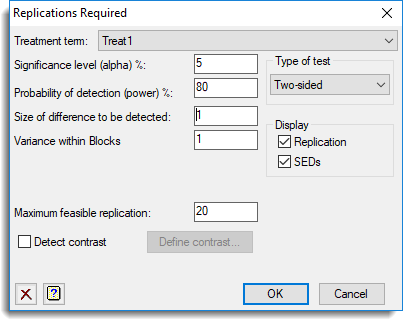This calculates the number of replicates required for a design to detect a given level of response between two treatment groups given a specified probability of detection and confidence level. The number of replications is calculated for the design that is currently specified within the Generate a Standard Design dialog.

When you click OK Genstat calculates the number of replications and prompts you to select one of the following options:
| Apply | Close the dialog and enter this value in the Generate a Standard Design dialog. |
| Cancel | Close the dialog without marking any changes |
| Change | Close the dialog so you can change the number of replications. |
Treatment term
A dropdown list of the treatment terms in the current design. The calculated power will be for a difference between two means in this treatment means table.
Significance level (alpha)%
Significance level as a percentage (0-100) at which the response is required to be detected. The default is 5%.
Probability of detection (power)%
Probability of detection as a percentage (0-100) that is required i.e. the required power of the test. The default is 80.
Size of difference to be detected
Size of the difference between TREATMENTS effects that is to be detected.
Variance components
These are variance components that have been evaluated from previous experience. If you have similar studies, these can be estimated from the ANOVA output. Set the option PRINT=stratumvariances to print out the required values. The number of variance components required will vary between 1 for a simple design with no blocks or randomized blocks, to 3 for split-split block designs.
Maximum feasible replication
Maximum feasible number of replicates. The SEDs will be printed for replications up to this value. A warning will be produced if this is set to too small a value, less than that required for the specified power of the test.
Detect contrast
Calculate the power of a specified contrast between means in the treatment terms. Click Define contrast to open the Define Contrast Variate dilaog and set the contrast.
Type of test
Specifies the type of test. You can use a One-sided or Two-sided t-test. Alternatively, if you select F-ratio the size of difference is taken to be the maximum difference between the effects of treatment term, and uses an F-test. The other settings enable you to test for Equivalence or for Non-inferiority. With equivalence, the size of difference provides a threshold below which the treatments can be assumed to be equivalent. For example, if the treatments have effects e1 and e2, the null hypothesis that the treatments are not equivalent is that either
(e1 – e2) ≤ – size of difference
or
(e1 – e2) ≥ – size of difference
with the alternative hypothesis that they are equivalent, i.e.
-size of difference < (e1 – e2) < size of difference
With non-inferiority, the size of difference again specifies the threshold for the effect of one treatment to be superior to another. For example, to demonstrate non-inferiority of treatment 1 compared to treatment 2, the null hypothesis becomes
(e1 – e2) ≥ -size of difference
which represents a simple one-sided t-test.
Display
Specifies the output to be displayed.
| Replication | Displays the required number of replications |
| SEDs | Table summarizing the situation for each feasible number of replicates. This contains the residual degrees of freedom, the residual mean square and the resulting standard error of difference (sed) |
Action buttons
| OK | Calculate the number of replications required and close the dialog. The calculated replications will be automatically inserted as the number of levels in the Replications or Blocks field in the main window . |
| Cancel | Close the dilaog without further changes. |
See also
The number of replications can be calculated in the command language using the ASAMPLESIZE procedure.